8 Subtle Easter Eggs Hidden In The Beatles’ Songs
Wait, so who’s the Walrus?
Alex Leadbeater
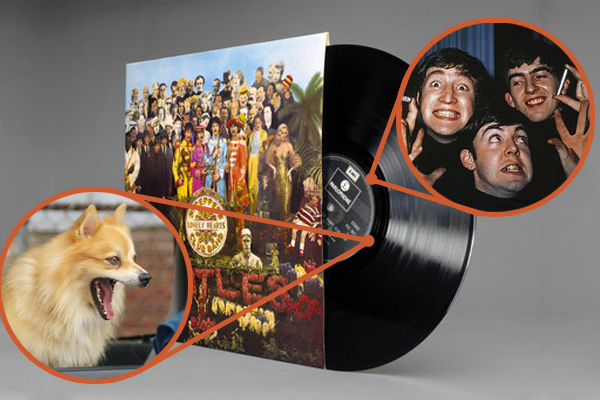
SOURCE // Apple Corp/Flickr
The Beatles were always known for being a bit playful with the general public. Making a film about how popular they are, doing an impromptu gig on the top of Apple Corps (heck, naming their record company Apple Corps), and that whole palava about being bigger than Jesus, they always knew how to toy with the press and their fans. They even admitted to having experimented with tea… and biscuits.
But their public persona was just part of their cheekiness. The band’s entire discography, particularly that which came out after they decided to quit touring and commit to the recording booth, is chock full of in-jokes, shout-outs and other cool tidbits explicitly snuck in there for their fanbase to obsess over decades into the future.
There are, of course, all the call-backs to earlier songs that are always good for a smile – in I Am The Walrus John Lennon instructs you to “See how they fly like Lucy in the sky” and All You Need Is Love ends in a (somewhat impromptu) rendition of She Loves You’s chorus. But they’re obvious to anyone with even a passing knowledge of the Fab Four – there’s much more hidden in their songs than those clear Easter eggs.
So pop on your favourite album (on LP, ideally, although the 2009 CD remasters are a fine consolation) and take a look at eight awesome Easter eggs the greatest band of all time hid in their music.
Honourable Mention – The (Alleged) Homophobic, Anti-Semitic Slur In Baby, You’re A Rich Man
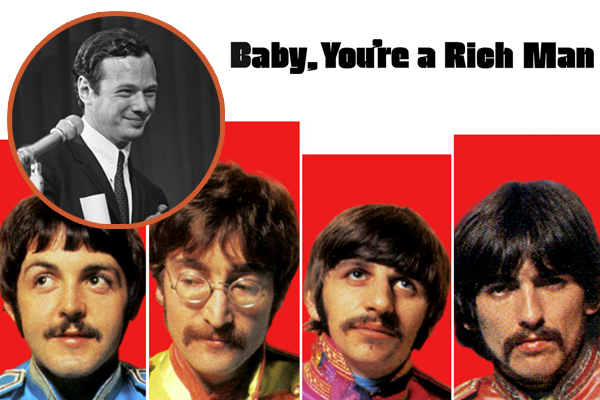
SOURCE // Apple Corp./Wikipedia
One of the longest standing Easter egg rumours says that, at the very end Baby, You’re A Rich Man, John Lennon can be heard twisting the song’s lyrics a little to “Baby, you’re a rich fag Jew”, a rather barbed joke directed at the band’s manager, Brian Epstein.
It fits the theory that the song, which was a meshing of two separate pieces written by Lennon and McCartney, was somewhat directed at Epstein (particularly in reference to him kicking his drug habit) and the joke is what you expect from Lennon’s sense of humour. However, it doesn’t seem to be founded in any real truth – although the final seconds of the song do feature Lennon saying the title lyric with more purpose, it doesn’t sound that much like the insult.
8. John Lennon Swears In Hey Jude
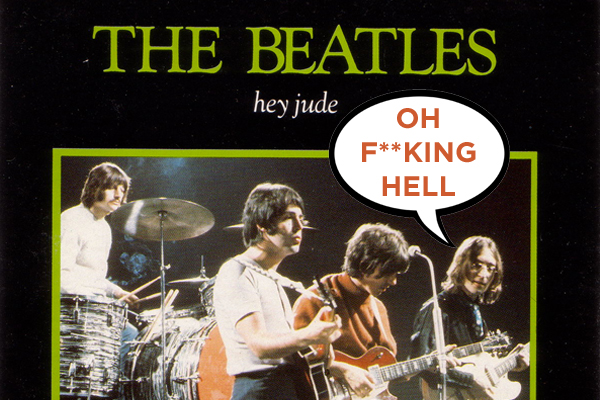
SOURCE //Apple Corps.
Hey Jude was originally written by Paul McCartney for John Lennon’s son Julian (Hey Jules) to help him deal with his parents splitting up. But you already knew that (and even though there’s a name change, it’s barely an Easter egg).
No, the reason I’m bringing up Hey Jude is because there’s another hidden goodie in the song. So hidden, in fact, that even though it comes at a key point, in all the times you’ve listened to it you’ve probably never noticed it.
Around the three minute mark (2:56 to be precise), just before the song turns into its “Na na na na na na naaaaaa” crescendo, you can hear someone semi-clearly exclaim “Oh fu*king hell”. This is often attributed to Paul McCartney responding to mucking up a chord, although that’s not really that likely (he’s obviously the singer on the master take, and it sounds more like John anyway). Regardless of who said, there is a definite F-bomb in the song, something you can imagine the band were pretty happy to sneak into an otherwise radio-friendly tune.
The version of the song used by Cirque du Soleil for their show Love cuts out this background expletive, and also altered the tone of the song going into the uproarious chorus – the lead-in lyric is “Let her into your heart” instead of the swear-covered “Let her under skin”.
7. John And George Mock Ob-La-Di Ob-La-Da In The Song Itself

SOURCE // Apple Corps.
There is of course no end to the love of The Beatles and their music, but some of their more out-there works aren’t immune to criticism. One of the most widely derided songs from their discography is Paul’s pseudo-reggae Ob-La-Di Ob-La-Da, which has placed in several “Worst Song Ever” lists (although you do feel that’s only because of its presence alongside the rest of the Beatles’ oeuvre – it’s an interesting song at the very least).
It’s not just latter-day assessments that have worn Ob-La-Di Ob-La-Da’s reputation though – some of the band themselves disliked it from the very start.
John was particularly vocal about his hatred of the song, at one point storming out of the recording, and there’s traces of that irritation in the finished album-version. On top of various studio directions hidden underneath the music, at various points John and George pipe in just after Paul’s finished a line to mock the lyrics; after both cases of “Lets the children lend a hand”, you can hear them shouting out “arm”, “leg” and “foot”.
The ribbing continued on the second-half of The White Album – in amongst all the nonsensical lyrics of Savoy Truffle, Harrison included the line “We all know Ob-La-Di-Bla-Da”, another dig at the controversial song.
It’s a rather humorous in-joke, but also goes to show how, as time went on, The Beatles’ internal relationships were less than harmonious. Something Let It Be, the band’s fourth film, would attest to. If, you know, Paul and Ringo would agree to rerelease it.
6. The Dog Whistle And Other Gibberish At The End Of A Day In The Life
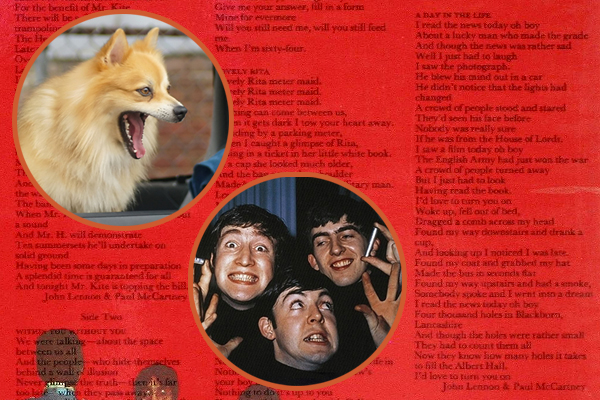
SOURCE // Apple Corps./Flickr
On top of in-jokes and call-backs stuffed into the songs, there were some literal hidden pieces of music on The Beatles’ albums. There was a short, thirty second run-out groove at the end of LPs that that was usually left empty, but was employed by some creative bands to sneak in extra songs that don’t appear in the song list (this tradition is why you still get songs hidden away at the end of the final track on album).
The best hidden (and by that logic most notorious) is the jabbering at the end of A Day In The Life – after about forty-five seconds of silence an edit of the bands studio chatter plays, saying something akin to “Never to see any other” over and over. Although originally created specifically for the run-out groove, it’s been reproduced on all subsequent album versions of the song – keep listening on iTunes and there it is. However, the LP (but not the CD), also featured an extra, annoying sound just before the inner grove – an inaudible high pitched note designed to send dogs crazy. You can just imagine Lennon getting ridiculously excited over the simple idea of irritating their owners.
Her Majesty, in terms of chronological release The Beatles’ final song, also began life in this manner – it was hidden right at the end of Abbey Road, following a long bout of silence after The End. However, for completions sake, on the CD (and all subsequent releases) the little ditty dedicated to Queen Elizabeth II was listed as its own track, so loses its little-known status.
5. The Barely Audible Explanation For Get Back’s Sound
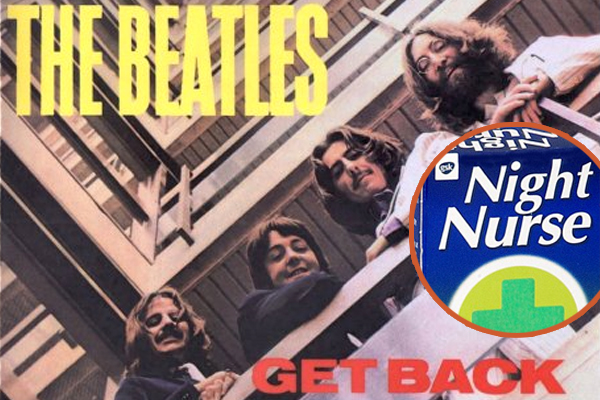
SOURCE // Apple Corps.
There’s a plethora of hidden dialogue in the background of Beatles tracks, either put in purposely (see this pushed to the extreme with Revolution 9) or accidentally left in the background of a recording. Nowhere is this shown so completely than Get Back, which has examples that are both painfully overt and incredibly subtle.
The album version ends with some audio clips from the none-more-iconic rooftop gig – “I’d like to thank you on behalf of the group and ourselves, and I hope we passed the audition”. As the final song on Let It Be, the final record released, it’s a pretty touching end to the band’s time together.
However, that’s incredibly obvious and nowhere near as interesting as this other, ridiculously hidden line. On the single version of the song (available subsequently on single and alternate collection Past Masters Vol. II), you can hear incredibly faintly at the end of the song’s main body (about 2:32) George Harrison saying… something.
It’s so quiet that making out exactly what George is saying is pretty damn-near impossible, but some pretty cool ideas have been put forward – the odd “It’s giving him some nightmares” or “Let’s give him some might, guys,” which makes sense as the long is just heading into its lengthy the final reprise. The best, and certainly most cohesive, however, is that he’s saying “Let’s give him some Night Nurse”, an explanation for Paul’s minorly off voice – he has a cold.
Whatever the case, the fact it’s just barely audible (once you spot it you’ll never unhear it though) means it was purposely left in the edit just to spark such wild and utterly fruitless discussion.
4. Back In The USSR Is A Tongue-In-Cheek Parody Of The Beach Boys
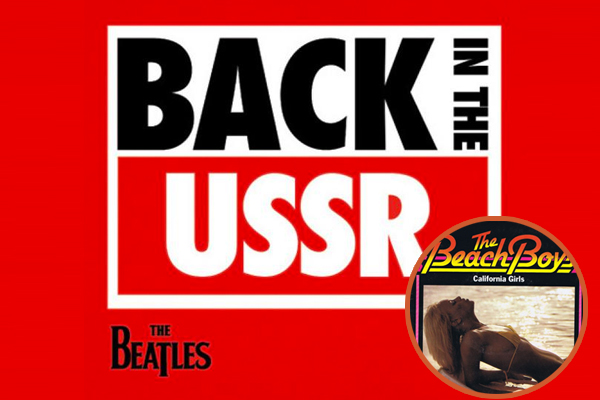
SOURCE // Apple Corps.
Rising up as typical pop bands in the early-sixties, only to evolve with and influence the culture as the decade wore on, there’s a lot of similarities between The Beatles and The Beach Boys. So much so that they both had a big influenced on each other; Pet Sounds was created out of a desire to top The Beatles’ heavily progressive Rubber Soul, which in turn motivated Sgt Pepper.
There’s even direct reference to America’s Band in some Beatles songs. Girl features “tit, tit, tit” over its middle eight after the band heard The Beach Boys use a similar “la, la, la” (something referenced in Brian Wilson biopic Love & Mercy). Although that’s nothing compared to what they did with the opening of their self-titled album (oh yeah, The White Album is just a colloquial name for the doubled-sided record simply known as The Beatles), with a song lightly mocking Wilson and Bros. all-American sensibilities.
Back In The USSR may seem like a “bigger than Jesus” style shrugging off of the Cold War (which it is on one level – there’s a lot of cool contextual references in there), but in doing that it’s also drawing a line under the differences between the two bands; the entire thing feels like a pastiche of The Beach Boys, with the line “The Ukraine girls really knock me out” a direct reference to California Girls. The title itself, meanwhile, is a nod to Chuck Berry’s Back In The USA, making this a plethora of references to American greats.
3. The Many References To The Paul Is Dead Conspiracy
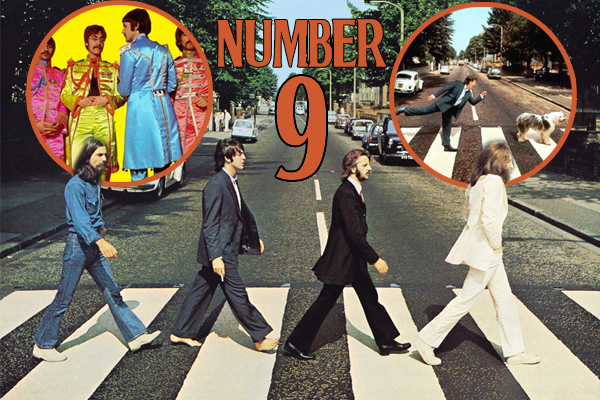
SOURCE // Apple Corps.
In January 1967 Paul McCartney was killed in a car crash. Not wanting to ruin The Beatles cash cow, a major conspiracy was concocted where a lookalike would pose as Paul and the band would continue as “normal”.
Or at least that’s what a rabid fan theory created by some students in 1969 that is so bonkers it gained some serious mainstream traction suggests. Although propagated by a true life accident, people began to read into The Beatles’ output for clues that Paul McCartney was indeed dead.
Things initially gravitated around Sgt. Pepper, the first album since his proposed death; the introduction of Billy Shears at the end of the opening eponymous song was taken to be the debut of Paul’s replacement (it is, in fact, a remnant of that album’s initial concept as a piece by the Lonely Hearts Club Band – Ringo, who sings With A Little Help From My Friends straight after the name drop, is “Billy”) and the back of the LP featured Paul with his back to the camera, suggested to hide his identity.
And then things get ridiculous, with a never-ending run of “clues” uncovered. At the end of Strawberry Fields Forever, John can be heard saying “I buried Paul” (actually a mishearing – it’s “Cranberry sauce”) and on the front of Abbey Road Paul is barefoot because he’s, well, dead. Best of all, when the titular “Number nine” of Revolution 9 is played backwards, it sounds like “Turn me on, dead man” (which, in the theories defence, actually makes just about much sense as any other justification for that song).
How much of this was the band playing with everyone and how much was simply overeager theorists is unclear, but boy is it a lot of fun either way. The final stage of the joke came decades after the band’s break-up, when the still very-much alive McCartney did a live tour called (and this is a doozy) Paul Is Live.
2. The Walrus’ Identity
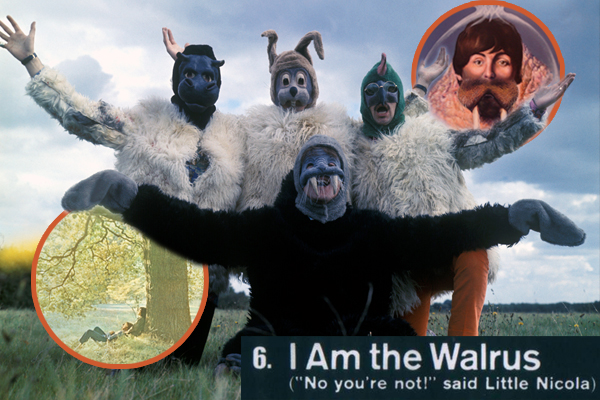
SOURCE // Apple Corps.
I Am The Walrus typifies The Beatles at their most unashamedly psychedelically playful. Absolutely bonkers (and that’s putting it simply), one of the best readings (and personally my favourite) is that everything, from the “Yellow matter custard” to the King Lear quotes at the end are purposely nonsensical, mocking the people who tried to read immensely deep meaning into the band’s lyrics.
This theory is backed up by the way the band, particularly the song’s writer, Lennon, dealt with its central “question”; just who is the Walrus? It’s John singing, sure, but the song is so abstract that means very little. On top of that, the track-list on the soundtrack for Magical Mystery Tour featured the note “No you’re not!” said Little Nicola” (itself a reference to the TV movie).
This became such a major question that the band played with the fans, dropping confessions and clues throughout the rest of their discography – in Glass Onion John sings “The walrus was Paul” (which also doubles as a playful insert in all that “Paul is Dead” theorising) and Come Together boasts the suitably nonsensical “He got walrus gumboot”.
The concluding truth, however, is much more downbeat. In God, John Lennon’s personality bearing account of his life as the Beatles broke-up, he proclaims “I was the walrus, but now I’m John.” The dream truly is over.
1. The Final Joke In Free As A Bird
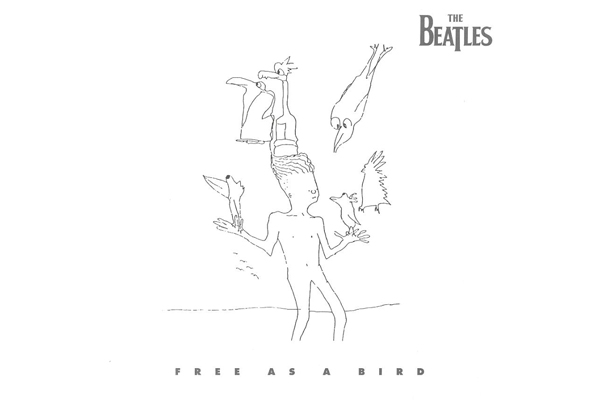
SOURCE // Apple Corps.
What The Beatles’ final album actually is depends on whether you go by release date (Let It Be) or recording date (Abbey Road), but either way you look at it, by the end of 1970 they were finished.
Well, almost. As part of the mammoth Anthology initiative in the mid-nineties (which boasted a definitive, eleven-hour documentary charting the band’s entire story and a trio of exhaustive double-CDs of alternate takes), two early recordings John Lennon made before his death were finished by the remaining three Beatles and released as singles; Free As A Bird and Real Love.
And, because twenty-five years apart had done nothing to quash Paul, George and Ringo’s playfulness, they snuck in one final Easter eggs for fan to find in Free As A Bird. At the very end of the song you can hear some garbled speech that sounds something like John saying “Made by John Lennon”. However, if you play it back, it’s revealed to be something much more touching; Lennon saying “Turned out nice again”. Yes. Yes it did.
What other Easter eggs are there in hidden The Beatles’ songs? Share any we missed down in the comments.

No hay comentarios:
Publicar un comentario